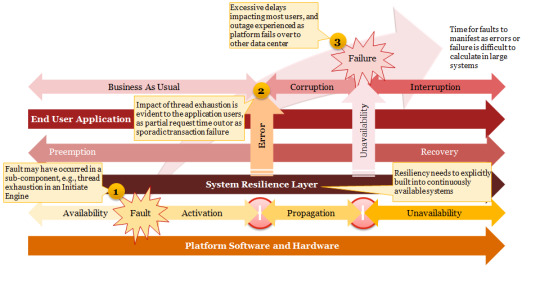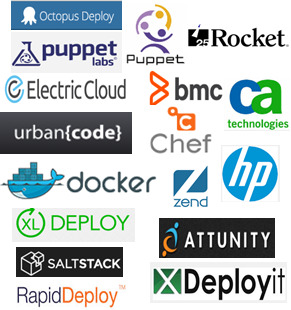Timely articles on shifting paradigms in the world and their impact on business models, technology and social ramifications...
Don't wanna be here? Send us removal request.
Text
Interesting blogs

I often get asked how one keeps on top of everything. Think that a trick is to have someone smarter do some filtering for you and share their perspectives.
With that, some blogs that I have been reading lately include:
https://devblogs.nvidia.com/parallelforall/ GPUs are enabling some cool things these days, including AI and realtime visualization of large data sets
https://blogs.dropbox.com/tech/ Posts are perhaps once a month though it is always interesting. One of the original unicorn club members and does not tend to disappoint in that regard
http://a16z.com/ Continues to talk about the up and coming things. For instance, the post yesterday is quite interesting on where voice UI is headed (though it kinda misses out on what Amazon is doing). I suppose you need to keep in mind that they are promoting their portfolio companies (past and present) so a bit of 'reading between the lines' is required
http://techblog.netflix.com/ If you are into how Netflix does what it does. I actually used Netflix last month and have to say that there is quite a bit of ingenuity in terms of the UX and how they build out recommendations. Tends to be more on the techie side of things though.
1 note
·
View note
Text
Are there any insurance companies on Earth that will insure Lyft, Sidecar and UberX drivers?
State of Insurance market for ride sharing Answer by Nauman Noor:
This is an evolving area and I think that all the responses to date were accurate at the time of writing. One has to keep in mind that innovation in the Insurance field is a bit slow, as it is heavily regulated at a state level and product enhancements can take 3 - 5 years to get to market. In terms of insurance around ride sharing, I have to say that Department of Insurance for California is the most progressive though it makes sense as most of the ride sharing aka TNC ('Transportation Network Companies') are HQ'ed out of that state. Recently (March 2015), the NAIC put forth a bill that is supported by State Farm, Allstate, Farmers Insurance, USAA and others to ensure that there is adequate coverage for the driver 'off duty', while waiting for a ride, in transit to pick up and then with the passenger. (btw, Erie Insurance has a great infographic on the timing aspects) In the meantime, Uber has a partnership with Metromile (who is a MGA for National General Insurance) which is charges by the mile (Pay as you drive model) in California and most states which recognize the notion of TNCs (Transportation Network Companies) like Indiana, Illinois. Other insurance companies include USAA (piloting in Colorado as of Feb 2015), Erie Insurance and GIECO (in Maryland and Virginia). Given the position being proposed by NAIC, we should expect that other insurance companies will start acknowledging ride sharing and potentially offer endorsements to ensure that the policyholders are covered (and if already so, clarify the confusion especially at time of an incident). Hope this helps.
Are there any insurance companies on Earth that will insure Lyft, Sidecar and UberX drivers?
0 notes
Photo

The recent Bloomberg outage got some press in terms of the overall reliability of the infrastructure. Given that the markets trade around the clock, Bloomberg needs to provide what is essentially continuous availability to its clients when it comes to the applications (including chat), data and overall network.
Though the investigation is undergoing, it would not be of surprise if there is some facet of human error in the overall cause, while it could also be a design issue which resulted in an outage due to a combination of accentuating circumstances not seen before.
When it comes to continuously available systems, the name of the game is to detect potential faults first, and then to mitigate those before they result in errors that can result in outages. Should an outage manifest itself, having a level of redundancy allows for timely recoverability. A time based depiction of such a pattern is illustrated below:

Removal of the human factor requires diligent automation of various key IT processes such as build, and release of deployments. This allows for rapid recovery and rollback if necessary as well. Of course, all this is predicated on the processes being automated are sufficiently robust, and support resiliency and continuous availability guiding principles. This is one of the areas that Devops seeks to address, though it tends to be lost in the marketing hype that whose crescendo is reaching the same level as that of BigData.
Some of the vendors include CA, BMC and a slew of startups:

Anticipate a wave of marketing materials on how respective vendors position their solution as a mitigation on such outages...
2 notes
·
View notes
Text
Why do some developers at strong companies like Google consider Agile development to be nonsense?
Answer by Russell Wark:
Jasmine said most of what I think. Good answer. Companies like Google have seen through all the trendy bluster surrounding agile (especially the fetid abomination that is Scrum), they've taken the few bits of the process that work and dumped all the management fad cruft (of which there is rather a lot). They have realised that every developer is different, each developer has their own processes that they work best with, and that the focus should be on the end product, not how to get there. I'm OK with using a Kanban board. I'm even OK with end user-centric tasks to a certain extent. That's more or less where it ends. I am not OK with the stupid, asinine terminology. We're developers. Do we really need more rubbish terminology in our lives? I am not OK with the short-termism of 'sprints' that inevitably end up with you having to refactor code time and time again when the next set of 'user stories' come in. I am not OK with the lack of strategic thinking when it comes to program design and software architecture. I am not OK with blatant micromanagement masquerading as 'the next big thing'. I am not OK with 'story points' or 'planning poker'. These are estimates of effort, not time, and hence utterly useless. I am not OK with daily standups. The Kanban board should tell everyone what they need to know, not this silly ritual lifted straight from Alcoholics Anonymous. I am not OK with all the other meetings either. Waste of good development time. Write me a f**king email. I am not OK with 'agile coaches' - the dev world's evangelical religious zealots peddling their ridiculous creed to companies on the promise of increased productivity, new jobs for increasingly irrelevant middle management (scrum masters and product owners) and the chance to say they do something trendy like 'agile', and then charge the company a fortune for the privilege. But, most of all, I am not OK with the homogenisation of developers that takes place in Scrum environments. It's extremely hard to be creative and do any out-of-the-box thinking when you're being micromanaged. And there's a whole generation of young developers coming into the workplace and thinking this is how it's supposed to be done. WTF?
Why do some developers at strong companies like Google consider Agile development to be nonsense?
0 notes
Text
Is patent infringement liability insurance commercially available? If so, what are typical rates and terms?
What types of patent infringement liability insurance is available? Answer by A Quora admin:
As Craig mentioned, it is generally available and there are quite a few variables that go into its pricing. Generally, three types of insurance policies in this area:
Defense Only: Covers cost of defending an infringement suit (just the defense). They do to not cover any damages that may be awarded. This type of coverage is for small companies with annual revenues in the range of $0.5M to $25M and have annual policy premiums that amount to a few thousand a year
Defense and Indemnity: Provides defense coverage in the event of a patent infringement suit and pay damages if liability is determined. These policies are generally designed for larger companies with annual revenues in excess of $50M. Annual premiums for such policies can range from a few thousand to $20K - $30K (again depends on your company, industry, prior claims, etc.)
Offensive: Reimburses legal expenses associated with pursuing an infringing party. Offensive policies are written in standard limits that range from $100,000 to $500,000. Annual premium is typically 1 - 1.5% of the covered limit. Generally for small companies whose business model is predicated on preserving differentiation through attained patents.
Insurance companies attempt differentiation by adding additional riders as part of the base coverage or as value add. These include loss of business income. loss of royalties and license fees, product redesign costs, etc.
Is patent infringement liability insurance commercially available? If so, what are typical rates and terms?
0 notes
Text
What are some cultural differences between Canadians and Americans?
Cultural differences between Canadian and Americans illustrated via a joke Answer by Bevan Audstone:
I've been waiting for this one Joke will explain all. How do you get 100 New Yorkers out of the pool? Answer: Say "Every one STAY in the pool! How do you get 100 Californians out of the pool? Answer: Say "This pool has been CHEMICALLY TREATED for your protection! How do you get 100 Republicans out of the pool? Answer: Say "Being in this pool shows your support for the FEDERAL GOVERNMENT How do you get 100 Democrats out of the pool? Answer: Say "This pool will be FUNDED COMPLETELY by the people in the pool!' The difference between Canadians and Americans? HOW DO YOU GET 100 CANADIANS OUT OF THE POOL? ANSWER: SAY "Please get out of the pool."
What are some cultural differences between Canadians and Americans?
0 notes
Photo

Just like building construction follows architecture informed blueprints, Enterprise Architecture (EA) drives technology blueprints that help align everyone on what is going to be accomplished when and what outcomes are going to be realized.
EA plays an instrumental role in aligning the technology and related investments to the business objectives. Though there are books on this topic, it basically comes down to:
Business value realization - what are the capabilities needed to realize my business objectives?
Technology management - how do I balance re-use, innovation and cost containment?
(most importantly) Communication - EA bridges the communication between the technology and business. The artifacts help the business stakeholders understand the trade-offs, benefits and risks, while they assist the IT organization understand the delineation of responsibility, integration points and changes in the overall environment.
0 notes
Photo
There is no mention of the telematics and other data that cars can collect and then send back to the manufacturers and potentially dealers. Everything from driving statistics (all anonymous I am sure), engine metrics and potentially validation of engine parts. The last one can be to monitor use of used or grey market parts (analogous to how HP and others check for third party non-approved cartridges).
If that is the case, one would hope that consumers are not paying for the bandwidth charges associated with the telemetry being broadcasted in the background...

Here’s what automakers can do when cars have built-in smartphone capabilities.
It’s no secret that cars are trying to replicate the smartphone experience. Touchscreen interfaces are common in today’s cars, dashboard designers take UI tips from iPhones, and automakers want to build apps for cars. And starting this year, large automakers like General Motors are taking the next obvious step and integrating 4G LTE service into their cars. Drivers pay a monthly service fee for in-car 4G that’s separate from their smartphones, and use it for an array of services from movies for kids in the backseat to sophisticated GPS-on-steroids solutions. It’s a win-win for automakers, the dealers who sell the 4G add-ons, and carriers like AT&T. But is it a win for consumers?
Read More>
51 notes
·
View notes
Photo

Musings from the World of Consulting turned 3 today! Cannot believe how quickly time flies by.
0 notes
Link
A digital currency beyond the reach of central banks is gaining acceptance. What does this mean for the dollar?
For those lacking a subscription, I have summarized the key messages:
Bitcoin's growing acceptance will not undermine the US dollar
Bitcoin lacks attributes that are typical of a reserve currrency
Key reserve currency attributes include:
Liquidity
Controlled volatility
Confidence, instilled by sound monetary policy and regulation
Bitcoin's perceived value may diminish as more copycat virtual currencies emerge Recent surge in bitcoin is due to Chinese interest. Potential reasons include closed capital account, lack of sound alternatives and desired for diversification
0 notes
Text
Languages used often in analytical circles
Outside of commercial tools like SAS, there is a lot of innovation that uses open source languages to get the necessary information from the underlying data.
Some popular languages include:
Python
Very fragmented but comprehensive scientific computing stack
Pandas, scikit.learn, numpy, scipy, ipython, & matplotlib are popular scientific computing libraries
IPython notebook makes a nice interactive data analysis tool
All the benefits of a general purpose programming language
Unfortunately slow
Some of the scientific computing stack is still stuck in Python 2.7
Very good for problems that don’t come as a simple feature matrix, between tools like pandas and nltk
Incredible open source ecosystem
R
As a general rule, if it’s found to be interesting for statisticians, it’s been implemented in R
High quality libraries with a good focus on unit testing
Nice interactive data analysis tool through things like RStudio
Language as a whole is slow and memory-intensive
Language itself makes me want to gouge my eyes out
Process for contributing libraries is unnecessarily manual and generally a pain in the ass
0 notes
Text
What are the primary traits of a great people manager?
Answer by Edmond Lau:
The Gallup Organization did a 25-year study that included over 1 million employee surveys and 80,000 manager interviews across 400 organizations to identify 12 elements of a great manager. Mark Buckingham and Curt Coffman reported on these elements in First, Break All the Rules, and Rodd Wagner and James Harter further refined the ideas in 12: The Elements of Great Managing. The 12 elements listed below correlated with increased productivity, profits, employee retention, and customer satisfaction.
http://businessjournal.gallup.co... Translated into more actionable behaviors, these 12 elements could be interpreted as:
Make sure employees know what's expected of them.
Provide employees with what they need to do their jobs.
Match the right person to the job.
Recognize and praise good work often.
Care about your employees as people.
Encourage mentoring.
Listen to employee opinions.
Connect employees' work to the larger mission.
Hold high standards.
Encourage friendships in the workplace.
Provide regular feedback (at least once every 6 months).
Help your employees learn and grow.
View Answer on Quora
0 notes
Link
Just got back from a Meetup on experimenting with iBeacon and more importantly, developing BLE aware applications. Quite insightful.
Ironically, BLE (Bluetooth Low Energy), a marketing term coined by the folks at Nokia, is now supported by most of Apple's product lines, and some of the Android devices (though Android itself has limited supported APIs).
Apple's approach to iBeacons is quite interesting and provides a foundation for interesting development of applications (locale driven context) as well as integration with future devices (ala Samsung Galaxy Gear Smartwatch).
In the next 6 - 8 months, one can expect to see retailers starting to adopt this - thinking of some of the more digitally savvy ones like Burberry - where their iOS application transmits your size information while providing information on new items / trends / backgrounds as one moves around the store.
Interesting times, indeed.
0 notes
Text
What web standard do insurance companies use to share data to 3rd party websites?
Summary of exchange standards in Insurance
How do websites like eHealth Insurance get their detailed quotes? XML?
View Question on Quora
0 notes
Text
Which is the best and most used Stock Exchange Index for Insurance Companies?
How to track the Insurance sector via an ETF? View Question on Quora
0 notes
Text
Is mobile phone insurance profitable?
Answer by Nauman Noor:
The short answer is Yes, very profitable. Asurion (Your Technology Protection Company) is the primary insurance provider for the top 4 carriers in the US - they have also recently expanded to Europe through an acquisition about 3 years ago. It is owned by the PE firms - an article in Businessweek circa 2010 (Is Asurion Cell Phone Insurance Worth It?) alluded to net profits being around $500M on revenues of $3.8B (of which about $400M is paid to the PE firms, leaving a net profit of $100M). It appears that for the most part, it is the only player (aside from Apple's coverage for the iPhone) that the wireless carriers use, hence providing to a certain degree some pricing power in terms of fees charged as well as sourcing of refurbished units that it provides claimants. Generally, as the article referenced mentioned, it is not a good deal for consumers given the payments involved, the deductibles applicable and the replacement value of the refurbished insurance. Hope this helps!
View Answer on Quora
0 notes
Text
Is the Gartner claim that by 2017 the CMO will spend more on IT than the CIO plausible?
Answer by Nauman Noor:
I don't work for Gartner nor am affiliated with them in any manner. I do feel though that directionally the statement is quite believable once you consider three key aspects: 1. What is being CMO spend being compared against If you were to review the spend in most IT organizations, a good 60-70% (if not a bit more) is dedicated to keeping things running (e.g., data center operations, electricity, leases on infrastructure, etc.). Another 10% - 15% is typically dedicated to bug fixes, maintenance and general support. That leaves 15-30% of the budget on providing new capabilities - discretionary spend in some ways. That then has to be divvied up across the various business areas and ofcourse, some at making IT function better. Gartner's projection is focused on purchase of new technologies and services by CMOs. In terms of an apples to apples comparison, it would be fair to compare and contrast this against discretionary spend. 2. What is included in the CMO technology spend Gartner's classification has more than just servers and analytics when it comes to CMOs and technology. It includes SEO tools, social media platforms, e-commerce and a variety of other things (see: Gartner Digital Marketing Transit Map). They are predicting that with the adoption of SaaS, CMOs will increasingly engage the providers directly versus relying on their inhouse IT counterparts. For instance, one can leverage Amazon for hosting the ecommerce site and fulfillment of orders as well. 3. Overall industry or segment specific Spending on IT does vary by industry, just as marketing spending does as well. So there will be sectors / segments where marketing spend is nominal (e.g., OEM manufacturers) while others will spend less on IT (e.g., retailers, restaurants, food services). I believe that the projections are at an aggregate level. As with any projection, the variance is huge and the key point to note is that CMOs will be increasingly engaged when it comes to use of technology within the enterprise. Over time, it will be viewed less as something that would be left to the CIO to be determined.
View Answer on Quora
0 notes